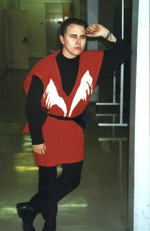Colors ExplainedPart Four: The PeopleUsually pre-created characters for a live-action game seem to be written as a set of intentions of what the character wishes to do in the context of this game. In Colors, I tried an entirely different approach. The game was not going to be complicated scheming and plotting, but rather, roleplaying in a stressful situation, and to roleplay you need to have characters that have history, complex motivations, and depth. Therefore the goal-oriented style of character generation was completely abandoned in favor of a rather RPG-like approach. I wrote 18 main characters (seven Nighthawks, nine Arctic Lighters, and Scourge), each 6-15 pages in length, concentrating on personal background, worldview and social relations. The supporting characters (a helicopter pilot, a doctor and the three superpowered mercenaries) were not as lengthy (due to lack of time on my part) but used a similar approach. Since much of the game would be just waiting for the wounded character to get back on his feet, the characters would not have much to do: I wanted them to be able just to talk to each other, compare their views of the world, maybe learn something new. After all, neither of the two teams had had too many opportunities to meet other superheroes before, so I figured it would be interesting just to see how they would get along. The character cast for a superhero game might easily have been a problem. One of the main points of the genre is that superheroes are extraordinary, far above and beyond normal humans, yet I wanted to run a game where all the player characters were in fact superheroes. How then would I emphasize the fact that these powers are so rare and fantastic when everyone in the game had them? The history-oriented character background seemed to be the answer: with the characters firmly rooted in the world around them, their players wouldn¹t feel that all there was was just "this game around them", but that the game was a part of a campaign, just the latest chapter in their personal history, and their personal history wasn't just superheroes meeting superheroes. Probably the most important single character in the game was Scourge. A contradictory person: on the one hand missing his friends in the Nighthawks and often regretting breaking his ties with them, on the other hand hurting terribly, blind with rage and unable to think of anything other than revenge. Scourge was written as a person with the tendency to act first and think (and regret) later, and these traits practically defined the main plot for Colors. The player I chose for Scourge was not very familiar with the superhero genre, but he could understand the character, and played him to the hilt. The Nighthawks had mixed feelings about him as well, and didn't particularily want to fight him, but they had all seen it as their duty to stop his gunrunning even though everyone would have preferred meeting him in more pleasant circumstances. Of course, there were some problems. One of the characters started the game wounded and incapacitated; he would spend his first two hours out cold. I talked with the player beforehand, and fortunately he saw no problem with this; anyway, he'd get to play the patient in a surgical operation the special effects unit was staging. Another problem was Scourge and his team. It would take them several hours to reach the safehouse, during which they would have nothing to do but drive around and talk to each other. Once again good players with complete characters that had a lot of written history would have to do. Previous: The Storyline * Back to Contents * Next: The Setup
|
